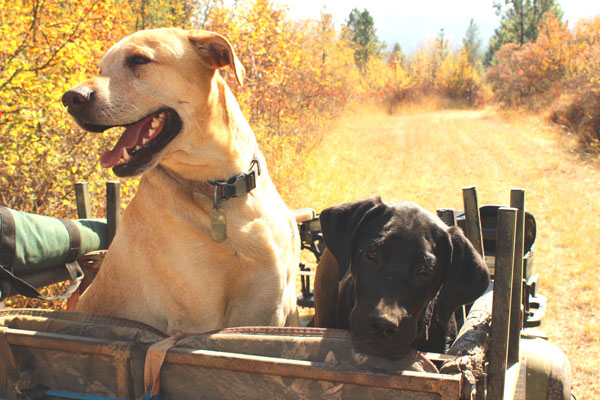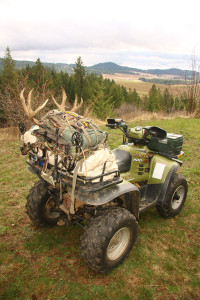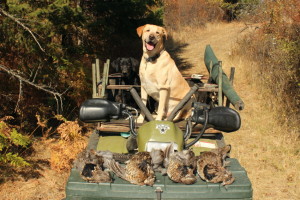
Summertime is a fine time to ride an ATV. I use them to reach remote trout creeks located far behind locked gates where full-sized vehicle traffic is prohibited but smaller ATV traffic allowed. I use them for summertime big-game scouting, and checking widely-scattered trail cameras. Most weekend warriors simply ride ATVs to get outside and see some country. We used to call this aimless motoring “joy-riding” as kids, but an ATV makes it both affordable (in terms of fuel consumption) and more fun, riding with the wind in your hair instead of in the seat of a hot vehicle, or sealed in with the air conditioner running. ATVs glide across rough back-roads much more comfortably than any 4WD truck or Jeep, and as hinted at before, open much more country for exploration.
 ATVs are all about fun and convenience. But fun can quickly turn to tragedy when ATVs are used improperly or ridden with undue care. Many ATV riders are seriously injured or killed every summer, something you definitely want to avoid. Hot-rodding is likely the No. 1 cause of these mishaps; that and drinking and riding. By hot-rodding, I mean things like jumping large berms or riding high up the banks of looping forest-road turns while showing off for peers, and generally just driving too fast for the conditions at hand. Some riders seem to forget they’re sharing forest roads with others. You may be a hotshot at handling your ATV, even at top speeds, but meet someone on the wrong corner and there’s little you can do to avoid a collision.
ATVs are all about fun and convenience. But fun can quickly turn to tragedy when ATVs are used improperly or ridden with undue care. Many ATV riders are seriously injured or killed every summer, something you definitely want to avoid. Hot-rodding is likely the No. 1 cause of these mishaps; that and drinking and riding. By hot-rodding, I mean things like jumping large berms or riding high up the banks of looping forest-road turns while showing off for peers, and generally just driving too fast for the conditions at hand. Some riders seem to forget they’re sharing forest roads with others. You may be a hotshot at handling your ATV, even at top speeds, but meet someone on the wrong corner and there’s little you can do to avoid a collision.
The drinking park of this equation: Well, do I even need to lecture on this aspect? I mean, really, it’s illegal, and just asinine. If you care nothing for yourself, at least think of those around you who are endangered by your reckless behavior. Hot-rodding is a similar issue. If you see yourself as the next Evel Keinevel, and are willing to endure the emergency-room visits and medical bills, at least find an area away from publicly-traveled roads, so you won’t involve innocent pedestrians in your reckless behavior.
On public roads, for God’s sake, please slow down—and drive on your own side of the road. I can’t tell you the number of times I’ve almost collided with a speeding ATV while driving to reach a fishing hole along a public road. Getting run into the ditch is easily tolerated. But I’d be deeply troubled if I was to hit an ATV sliding around a forest-road corner and seriously injure or kill the rider—even if it wasn’t my fault. Have some consideration for the general public. Again, you aren’t the only one out there. Slow down and drive defensively. Give yourself enough room to maneuver in case someone else is driving like an idiot, or just not paying attention.
When driving in groups including more than one ATV, it’s wise to signal the driver of encountered vehicles how many machines are following by holding up fingers. Make it emphatic, holding up fingers in a way that lets the driver know you’re indicating a number and not giving him the Peace Sign or flipping them the bird. This gives the driver fair warning so they can slow down and keep an eye out for followers.
Slowing down and driving defensively especially applies if you’re going to carry passengers. ATV manufacturers discourage passengers while riding ATVs, but it is a normal mode of operation in the Inland Northwest, especially with couples who want to enjoy the day together. When I’m carrying a passenger, be that my wife or one of our Labrador retrievers, I slow waaaay down. The added weight sacrifices some amount of control, and I don’t ever want to involve them in an accident. What I really have a problem with are those riding with a small child, driving too fast, erratically or with a beer in their hand. Hit the wrong bump, encounter a speeding vehicle on a blind corner and driving too fast or impaired can turn fatal.
And wear a helmet and eye protection. A helmet can be the difference between a simple broken arm, and a broken arm compounded by a serious head injury and death in the event of a simple roll-over. Besides, a helmet with visor, or safety glasses and helmet, keeps debris (like gravel kicked up by a passing truck) and flying insects (like bullet-like grasshoppers) out of your eyes. If you’re too macho to wear a helmet, at least insist your passenger wear one—especially young kids.
 ATV safety also applies to what you carry along with you in the event of a flat tire, unexpected breakdown or getting mired and unable to un-stick yourself. I have a water-tight plastic box bolted to the front rack of my ATV. In it are a couple emergency rain ponchos (full-blown rain gear if rain is in the forecast), several bottles of water, folding emergency fuel-tablet “stove,” small pot, waterproof matches, a couple dehydrated meals and energy bars and space blanket. These are included in case I must spend the night out after a breakdown. Also stashed in my box are a tire plug kit, mini air pump, basic tools, spare drive belt, folding handsaw and compact hatchet (for removing fallen trees from roads) and compact first-aid kit. When planning an all-day trek, I’ll strap a 2-gallon gas can on the rear (enough to get me at least 50-60 miles). Long ago I installed a winch to the front of my ATV. It has gotten me out of some sticky situations, pulled others out of the same, helped move road-blocking trees from my path and retrieve deer from rough spots.
ATV safety also applies to what you carry along with you in the event of a flat tire, unexpected breakdown or getting mired and unable to un-stick yourself. I have a water-tight plastic box bolted to the front rack of my ATV. In it are a couple emergency rain ponchos (full-blown rain gear if rain is in the forecast), several bottles of water, folding emergency fuel-tablet “stove,” small pot, waterproof matches, a couple dehydrated meals and energy bars and space blanket. These are included in case I must spend the night out after a breakdown. Also stashed in my box are a tire plug kit, mini air pump, basic tools, spare drive belt, folding handsaw and compact hatchet (for removing fallen trees from roads) and compact first-aid kit. When planning an all-day trek, I’ll strap a 2-gallon gas can on the rear (enough to get me at least 50-60 miles). Long ago I installed a winch to the front of my ATV. It has gotten me out of some sticky situations, pulled others out of the same, helped move road-blocking trees from my path and retrieve deer from rough spots.
ATVs are wonderful machines. They have completely changed the way sportsmen enjoy the outdoors, even if just puttering around to see the sights while “joy-riding” a weekend away. I access out-of-the-way fishing spots, discover remote hunting sites, and even scout out firewood without burning the excessive fuel my ¾-ton truck unfortunately consumes. But ATVs can also prove dangerous. With a modicum of caution and some good old-fashion horse sense, there’s no reason you should become part of the tragic statistics of those seriously injured or killed each summer in ATV accidents.
Have fun but be safe!